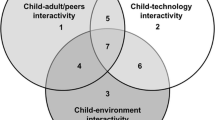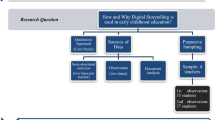Abstract
This paper aims at presenting the application of a grid for the analysis of the pedagogic functions of visual images included in school science textbooks and daily press articles about science and technology. The analysis is made using the dimensions of content specialisation (classification) and social-pedagogic relationships (framing) promoted by the images as well as the elaboration and abstraction of the corresponding visual code (formality), thus combining pedagogical and socio-semiotic perspectives. The grid is applied to the analysis of 2819 visual images collected from school science textbooks and another 1630 visual images additionally collected from the press. The results show that the science textbooks in comparison to the press material: a) use ten times more images, b) use more images so as to familiarise their readers with the specialised techno-scientific content and codes, and c) tend to create a sense of higher empowerment for their readers by using the visual mode. Furthermore, as the educational level of the school science textbooks (i.e., from primary to lower secondary level) rises, the content specialisation projected by the visual images and the elaboration and abstraction of the corresponding visual code also increases. The above results have implications for the terms and conditions for the effective exploitation of visual material as the educational level rises as well as for the effective incorporation of visual images from press material into science classes.
Similar content being viewed by others
References
Amann, K., & Knorr Cetina, K. (1990). The fixation of (visual) evidence. In M. Lynch & S. Woolgar (Eds.), Representation in scientific practice (pp. 85–122). Cambridge,MA: MIT Press.
Amettler, J., & Pinto, R. (2002). Students' reading of innovative images of energy at secondary scool level. International Journal of Science Education, 24(3), 285– 312.
Bader, R. (1990). How science news sections influence newspaper science coverage: A case study. Journalism Quarterly, 67(1), 88–96.
Bazerman, C. (1988). Shaping written knowledge: The genre and activity of the experimental article in science. Madison,WI: University of Wisconsin Press.
Bernstein, B. (1996). Pedagogy, symbolic control and identity: Theory, research, critique. London: Taylor and Francis.
Bucchi, M. (1998). Science and the media: Alternative routes in scientific communication. London: Routledge.
Bybee, R. (1997). Toward an understanding of scientific literacy. In W. Graber & C. Bolte (Eds.), Scientific literacy (pp. 37–68). Kiel, Germany: Institute for Science Education (IPN).
Colin, P., Chauvet, F., & Viennot, L. (2002). Reading images in optics: Students' dif-ficulties and teachers' views. International Journal of Science Education, 24(3), 313–332.
De Vos, W., & Reiding, J. (1999). Public understanding of science as a separate subject in secondary schools in The Netherlands. International Journal of Science Education, 21(7), 711–719.
Elliott, W., & Rosenberg, W. L. (1987). Media exposure and beliefs about science and technology. Communication Research, 14(2), 164–188.
Gamson, W., & Modigliani, A. (1989). Media discourse and public opinion on nuclear power: A constructionist approach. American Journal of Sociology, 95(1), 1–37.
Gross, A. (1996). The rhetoric of science. Cambridge, MA: Harvard University Press.
Halliday, M. A. K. (1996). On the language of physical science. In M. A. K. Halliday & J. R. Martin (Eds.), Writing science: Literacy and discursive power (pp. 54– 68). London: The Falmer Press.
Hansen, A., Cottle, S., Negrine, R., & Newbold, C. (1998). Mass communication research methods. London: Macmillan Press.
Hornig Priest, S. (1995). Information equity, public understanding of science and the biotechnology debate. Journal of Communication, 45(1), 39–54.
Irwin, A., & Wynne, B. (1996). Misunderstanding science? The public reconstruction of science and technology. Cambridge, UK: Cambridge University Press.
Jacobi, D. (1999). Le communication scientifique: Discours, figures, modeles (Science communication: Discourse, figures, models). Grenoble, France: Presses Universitaires de Grenoble.
Jacobi, D., & Schiele, B. (1989). Scientific imagery and popularized imagery: Differences and similarities in the photographic portraits of scientists. Social Studies of Science, 19(4), 731–753.
Koulaidis, V., Dimopoulos, K., & Matiatos, S. (in press). Science and technology centers as 'Texts'. Proceedings of the ninth learning conference, Beijing, University of Beijing, July, 2002.
Koulaidis, V., Dimopoulos, K., & Sklaveniti, S. (2002). Analysing the texts of science and technology: School science textbooks and daily press articles in the public domain. In M. Kalantzis, G. Varnava-Skoura, & B. Cope (Eds.), Learning for the future (pp. 209–240). Sydney, NSW: Common Ground.
Kress, G., Jewitt, C., & Tsatsarelis, C. (2000). Knowledge, identity, pedagogy pedagogic discourse and the representational environments of education in late modernity. Linguistics and Education, 11(1), 7–30.
Kress, G., & van Leeuwen, T. (1996). Reading images: The grammar of the visual design. London and New York: Routledge.
La Follette, M. C. (1990).Making science our own: Public images of science, 1910– 1955. Chicago, IL: University of Chicago Press.
Latour, B. (1987). Science in action. Cambridge,MA: Harvard University Press.
Layton, D., Jenkins, E., Macgill, S., & Davey, A. (1993). Inarticulate science? Perspectives on the public understanding of science and some implications for science education. Nafferton, UK: Studies in Education Ltd.
Leinhardt, G., Zaslavsky, O., & Stein, M. K. (1990). Functions, graphs and graphing: Tasks, learning and teaching. Review of Educational Research, 60(1), 1–64.
Lemke, J. L. (1993). Talking science: Language, learning, and values. Stamford, CT: Ablex Publishing Corporation.
Lemke, J. L. (1998). Multiplying meaning: Visual and verbal semiotics in scientific text. In J. R. Martin & R. Veel (Eds.), Reading science: Critical and functional perspectives on discourses of science (pp. 87–113). London and New York: Routledge.
Lemke, J. L. (2002). Notes on multimedia and hypertext. Online at: http://academic.brooklyn.cuny.edu/education/jlemke/papers/hypermodality/ travels-app.htm
Lijnse, P. L., Eijkelhof, M. C., Klaasen, W. J. M., & Scholte, R. L. J. (1990). Pupils' and mass-media ideas about radioactivity. International Journal of Science Education, 12(1), 67–78.
Lynch, M. (1985). Discipline and the material form of images: An analysis of scientific visibility. Social Studies of Science, 15(1), 37–66.
Lynch, M. (1990). The externalized retina: Selection and mathematization in the visual documentation of objects in the life sciences. In M. Lynch & S. Woolgar (Eds.), Representation in scientific practice (pp. 153–186).Cambridge,MA: MIT Press.
Messaris, P. (1994). Visual 'literacy': Image, mind and reality. Oxford, UK: West-View Press.
Meyrowitz, J. (1986). Television and interpersonal behaviour: Codes of perception and response. In G. Gumpert & R. Cathcart (Eds.), Inter/media: Interpersonal communication in a media world (pp. 253–272). New York: Oxford University Press.
Miller, T. (1998). Visual persuasion: A comparison of visuals in academic texts and the popular press. English for Specific Purposes, 17(1), 29–46.
Myers, G. (1990a). Writing biology: The social construction of popular science. Madison,WI: University of Wisconsin Press.
Myers, G. (1990b). Every picture tells a story: Illustrations in E. O. Wilson's sociobiology. In M. Lynch & S. Woolgar (Eds.), Representation in scientific practice (pp. 231–265). Cambridge,MA: MIT Press.
Myers, G. (1995). Words and pictures in a biology textbook. In T. Miller (Ed.), Functional approaches to written text: Classroom applications (pp. 113–126). Paris: TESOL.
Nelkin, D. (1995). Selling science: How press covers science and technology. New York: W. H. Freeman.
Phillips L. M., & Norris, S. P. (1999). Interpreting popular reports of science: What happens when the reader's world meets the world on paper. International Journal of Science Education, 21(3), 317–327.
Pinto, R., & Ametller, J. (2002). Students' difficulties in reading images: Comparing results from four national research groups. International Journal of Science Education, 24(3), 333–341.
Roth, W. M., Bowen, G. M., & McGinn, M. K. (1999). Differences in graph-related practices between high school biology textbooks and scientific ecology journals. Journal of Research in Science Teaching, 36(9), 977–1019.
Roth, W.M., & Laweless, D. (2002). Science, culture and the emergence of language. Science Education, 86(3), 368–385.
Trumbo, J. (1999). Visual literacy and science communication. Science Communication, 20(4), 409–425.
Veel, R. (1998). The greening of school science: Ecogenesis in secondary classrooms. In J. R. Martin & R. Veel (Eds.), Reading science: Critical and functional perspectives on discourses of science (pp. 114–149). London and New York: Routledge.
Author information
Authors and Affiliations
Rights and permissions
About this article
Cite this article
Dimopoulos, K., Koulaidis, V. & Sklaveniti, S. Towards an Analysis of Visual Images in School Science Textbooks and Press Articles about Science and Technology. Research in Science Education 33, 189–216 (2003). https://doi.org/10.1023/A:1025006310503
Issue Date:
DOI: https://doi.org/10.1023/A:1025006310503




